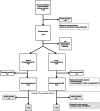Randomized Cross-Over Analysis of the Influence of Nitrogen Multiple Breath Washout on Spirometry in Monitoring Lung Function in Patients With Cystic Fibrosis and Primary Ciliary Dyskinesia
- PMID: 40637384
- PMCID: PMC12243717
- DOI: 10.1002/ppul.71189
Randomized Cross-Over Analysis of the Influence of Nitrogen Multiple Breath Washout on Spirometry in Monitoring Lung Function in Patients With Cystic Fibrosis and Primary Ciliary Dyskinesia
Abstract
Background: When monitoring lung function in patients with Cystic Fibrosis (pwCF) and Primary Ciliary Dyskinesia (pwPCD), nitrogen multiple breath washout (N2MBW) is usually performed before spirometry to prevent forced expiratory maneuvers from altering N2MBW results. The N2MBW may affect spirometry if cooperation decreases after a long period of examination or due to prolonged oxygen inhalation. The equivalence of these concepts has never been investigated in a randomized cross-over trial. We hypothesized that the order of pulmonary function tests (PFTs) would not influence the z-score FEV1.
Methods: A total of 47 clinically stable outpatients (36 pwCF, 11 pwPCD; 16.7 ± 8.1 years) were randomized into two groups. Each patient underwent N2MBW and spirometry at two consecutive visits (median interval 104 days): Group I: Spirometry followed by N2MBW (A), reversed order at the second visit (B), Group II reversed (B→A).
Statistics: For the equivalence test, a change in z-score FEV1 (primary endpoint) ±0.2 and lung clearance index (LCI2.5, secondary endpoint) ±15% was not considered relevant; therefore, changes outside this range were considered an intervention effect in the linear mixed model (p < 0.05).
Results: There was a significant deterioration in z-score FEV1 between the two appointments (period effect: -0.177; p = 0.012). The intervention effect and 95% confidence interval were within the equivalence range in both groups (z-score FEV1: 0.039; -0.0765 to 0.1539, LCI2.5: -0.082; -0.3691 to 0.2054).
Discussion: In our cohort the order of PFTs has no influence on the results suggesting that a greater flexibility in practice is possible without the risk of falsifying results.
Trial registration: German Clinical Trials Register (No. DRKS00027473).
Keywords: cystic fibrosis; multiple breath washout; primary ciliary dyskinesia; spirometry.
© 2025 The Author(s). Pediatric Pulmonology published by Wiley Periodicals LLC.
Conflict of interest statement
The authors declare no conflicts of interest.
Figures



Similar articles
-
Corrector therapies (with or without potentiators) for people with cystic fibrosis with class II CFTR gene variants (most commonly F508del).Cochrane Database Syst Rev. 2023 Nov 20;11(11):CD010966. doi: 10.1002/14651858.CD010966.pub4. Cochrane Database Syst Rev. 2023. PMID: 37983082 Free PMC article.
-
Nebulised hypertonic saline for cystic fibrosis.Cochrane Database Syst Rev. 2023 Jun 14;6(6):CD001506. doi: 10.1002/14651858.CD001506.pub5. Cochrane Database Syst Rev. 2023. PMID: 37319354 Free PMC article.
-
Inhaled mannitol for cystic fibrosis.Cochrane Database Syst Rev. 2018 Feb 9;2(2):CD008649. doi: 10.1002/14651858.CD008649.pub3. Cochrane Database Syst Rev. 2018. Update in: Cochrane Database Syst Rev. 2020 May 1;5:CD008649. doi: 10.1002/14651858.CD008649.pub4. PMID: 29424930 Free PMC article. Updated.
-
Exercise versus airway clearance techniques for people with cystic fibrosis.Cochrane Database Syst Rev. 2022 Jun 22;6(6):CD013285. doi: 10.1002/14651858.CD013285.pub2. Cochrane Database Syst Rev. 2022. PMID: 35731672 Free PMC article.
-
Conventional chest physiotherapy compared to other airway clearance techniques for cystic fibrosis.Cochrane Database Syst Rev. 2023 May 5;5(5):CD002011. doi: 10.1002/14651858.CD002011.pub3. Cochrane Database Syst Rev. 2023. PMID: 37144842 Free PMC article.
References
Publication types
MeSH terms
Substances
Grants and funding
LinkOut - more resources
Full Text Sources
Medical

